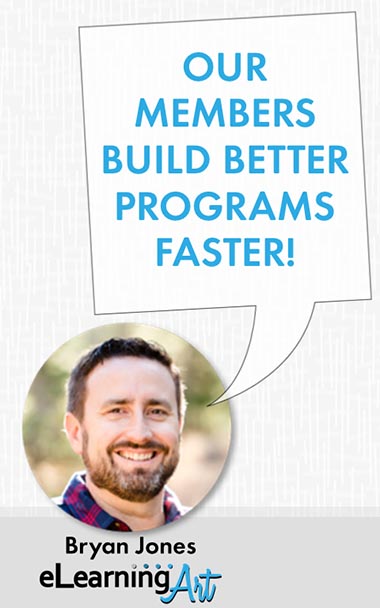Synopsis
When you’re working with eLearning layout templates, an important element is creating the background image that is behind the layouts. This tutorial walks you through several techniques to use textures and colors to create a custom background.
Video Script
Okay. So today I want to introduce you to a concept for creating backgrounds that are really good for eLearning templates. What you can do here is you can take a texture and add it to a color to create a background image.
So I think the best place to start is to just scroll through a couple of the finished blends, and then I’ll show you guys more on how you can create these yourself. So here are a few different ones where it’s circles, and question marks, and some other patterns. This one has a gradient color in it. Here’s a pretty simple background, it’s just stripes with a gray scale.
And I’ll just scroll through a few of these and you can take a look. And what you can do is you can drop other things on top of it to create say a quiz, or an interaction, and this then becomes more of your color theme and pattern that could – that could go with your company colors. Or something else you’re using within your content.
So let’s take a quick look at the components of what make this up. So you’ll see here that I have the selection/visibility pane open and I have a texture and I have a color here. So if I were to hide the texture, you’ll see that I just have a color, and it does have a gradient to it. And then if I got rid of the color, you’d see that I have a texture here that’s really just adding some black or gray to that background color.
So let me, let me show you something else real quick here. All right, first of all from within your color, if you wanted to – this is within PowerPoint, but you can use any other graphic editing tool. But here you’ll see I have a gradient fill and I’ve basically have added three different stops here, with the darker ends in the middle and a lighter one there.
And that creates a nice gradient effect there so that when I then drop that texture on top of it, it looks nice. Now there is two different types of textures that you can add on to it. So you could add one that is adding a darker shade to it, or you can add one that is actually adding a lighter shade to it. And let me show you that as well.
Okay. So the way that I work with the texture here, is I actually insert a shape and then do a picture fill. And that’s because within PowerPoint it’s difficult to change the transparency of a picture. You need to have actually a, the picture fill within a shape to do it. It’s a little work around. But let me just show you here, I would go fill, picture or texture fill, select from file.
And what I have here, you will see that’s the dots to reverse black, and we can do the opposite of that, which would be the dots to reverse white. And you’ll see what happens here. Okay. And here I’m going to have the transparency of seventy, but if you look at the difference between those two, it’s a very different effect here. It’s just basically the opposite.
And you can add these transparencies. You can create them yourself. I’ll show you some of the other ones that, that I have as well. So some of these are hard to see when it’s white on white, but you’ll see I have a bunch of different textures that I’ve already created that you can add right in there.
And you take that texture, you mix it with a color, and you have yourself a nice little background. So then one of the ways that I might use this within PowerPoint is for a template. So this would be my background that I’ve inserted onto the master slide, and then I add a whole bunch of layouts. And let’s actually look at it in a different view.
There you go. So you could add other, a bunch of other layouts that have a lot of open white space or maybe some perspective where you can then use this as a base for an eLearning course. So you can do it for this, or you can use it for a quiz. It’s really a pretty flexible way to create a background.
So again it’s just, you’re taking a texture that has transparency and then either a shade of dark or a shade of light, you’re adding that to a color that could be a solid color, it could be a gradient color, it could be a mix of colors. And then that’s creating your background, your background color.
Hope you found that useful. Thanks.


